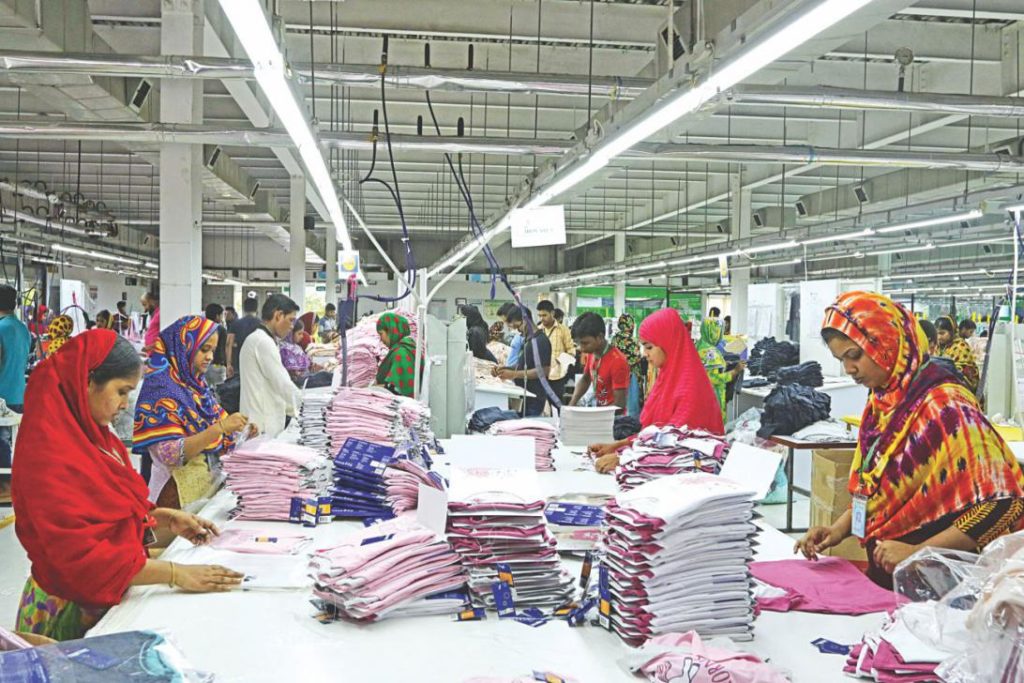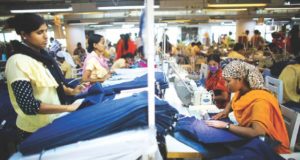By Mohammad A Razzaque
Published in The Daily Star on February 20, 2018

Photo: Amran Hossain/ The Daily Star
Bangladesh needs a strategy of export diversification
complemented by a policy of maximising overall exports
Export diversification has proven to be a formidable task for Bangladesh. If anything, export concentration—more specifically, dependence on readymade garments (RMG)—has increased further. Bangladesh’s export basket is four times more concentrated in a few individual product lines than the average of a developing country. Our Asian comparators such as China, India, Indonesia, Malaysia, Sri Lanka, Thailand and Vietnam, all have much more diversified export structures. The contribution of new products, identified by the six-digit level of the harmonised system of trade classification, to the overall export growth between 2005 and 2015, was less than five percent for Bangladesh in comparison to 78 percent for Malaysia, 42 percent for Vietnam, 32 percent for China, 25 percent for Sri Lanka and 20 percent for India.
For Bangladesh the issue of export diversification is much more complex and needs serious strategic thinking. Many observers seem to believe non-RMG exports cannot grow because of policy support provided to the RMG sector. There is often a suggestion that the RMG sector no longer needs any support and thus all policy assistance provided to this sector should cease to exist. These are flawed assessments. Given Bangladesh’s current situation the need for export expansion should not be compromised by the need for export diversification. Rather, a strategy of export diversification is to be complemented by a policy of maximising overall exports.
It is true that within the group of LDCs Bangladesh is considered as an export success story. But when compared with other developing countries, there appears to be no reason for complacency. With a population of 160 million, our current export volume of USD 35 billion is small in comparison with most countries of comparable size. The 91 million-strong Vietnam boasts an export volume of USD 170 billion; Indonesia exports USD 220 billion with a population of 258 million; the Philippines has a population of 101 million and exports USD 90 billion. Then again, much smaller countries in East Asia such as Malaysia and Singapore are extremely successful exporting nations. Therefore, Bangladesh must vigorously expand its exports to be at par with successful exporting nations among the developing countries. From this perspective, promoting export diversification and maintaining RMG sector dynamism must go hand in hand.
In recent times, the export sector has come under some strain. The growth in export receipts in the last fiscal year was just 1.7 percent. Persistent slowdown in global trade and increased pressure on external competitiveness due to several factors have contributed to this dismal performance. It comes as Bangladesh aims for USD 50 billion RMG exports with an overall export target of USD 60 billion by 2021. These targets now appear to be daunting prospects.
There is however huge potential for increasing RMG exports many folds given the expected growth of global apparel demand in the future. Available projections suggest that the annual global apparel consumption could exceed USD 2.5 trillion by 2025 (from currently USD 1.8 trillion), giving boosts to exports of clothing from various suppliers. And, revitalising and sustaining dynamism in the garment sector will help expand overall export faster.
Under an optimistic scenario, if RMG exports expand at a rate of 10 percent per annum for the next 10 years or so and the non-RMG sector also grows at the same pace, Bangladesh’s total exports in 2030 will be USD 100 billion. Although this will imply the relative significance of RMG exports as a part of total exports remains unchanged, it should contribute to significant broadening of non-RMG export base. On the other hand, if RMG export growth is going to be five percent per annum, overall export performance is going to be much less impressive. Therefore, RMG will have to play an engine role for rapid export expansion. It is also important to recognise that even within the RMG sector there exists massive opportunities for generating exports in new products (and thus diversification).
A strategy of export expansion with diversification will have to mitigate the adverse consequences faced by exporters as a result of Bangladesh’s weaker performance in various areas such as institutions, infrastructures, technological readiness, financial market development, etc. In the Global Competitiveness Index 2017-18 Bangladesh is outperformed by many of its comparators in terms of most of these indicators.
Such a strategy should also aim to tackle policy-induced disadvantages faced by the exporters. For example, appreciation of the real exchange rate undermines a country’s external competitiveness. Since 2011, the real exchange rate of the taka has appreciated by more than 50 percent. Similarly, the 7th Five Year Plan has emphasised on reversing anti-export bias in trade regime for boosting exports and promoting export diversification. This would require rationalisation of the tariff structure to dismantle disincentives for exporting.

Providing direct support is critical in addressing policy biases against exporters and other barriers that they face. One key ingredient in Bangladesh’s RMG-led export growth success was an elaborate incentive package, which became a characteristic feature of the trade policy regime in the 1990s. This included duty drawbacks on imports of intermediate goods, bonded warehouse facilities to enable exporters importing intermediate inputs duty-free, cash compensation schemes for the so-called non-traditional exports with the cash assistance rate for exporters not availing duty-drawback or bonded warehouse facilities, etc.
These incentives continue to operate, although the nature and depth of coverage for some of them have changed. For instance, since the early 2000s, such assistance for the RMG sector has been quite low. Currently (for 2017-18), this assistance is provided under different mechanisms: (i) export-oriented RMG firms, not using bonded warehouse and duty-drawback facilities, are eligible for cash assistance of four percent of the value of their export shipment; (ii) small and medium sized firms in RMG can avail additional four percent assistance; (iii) exporters exporting to new markets (other than Canada, the EU and the US) receive three percent cash assistance on f.o.b. value of exports; and (iv) RMG exporters exporting to Eurozone countries receive additional two percent cash assistance (to compensate for the taka appreciation against the Euro).
Several other sectors are eligible for cash assistance of higher rates. However, apart from leather and to some extent frozen shrimp and fish, there is no other sector with any sizeable export base to take advantage of available incentives for contributing meaningfully to overall export growth and diversification.
The current policy is clearly geared towards stimulating export response from the relatively less-established emerging sectors, and higher rates of assistance for them are justified. However, the overall ambition of the export policy, which is to raise export earnings to USD 60 billion by 2021, should not be overlooked. As such, all possible avenues for revitalising exports must be considered. This should include the option of keeping the existing cash assistance for the new sector while raising the level for others as well. For example, the 20 percent cash assistance for active pharmaceutical ingredients (API) can help encourage future expansion of the sector, but in the short- to medium-term any large export response is unlikely. On the other hand, as pharmaceutical products have already established a respectable export base and production capacity, comparable incentives granted to the sector will more likely result in significantly higher export earnings, helping export diversification efforts.
For the emerging sectors with currently small exporting capacity, it is important to maintain the support for a reasonably longer time period to provide them with policy consistency.

In some instances, non-RMG sectors cannot access certain incentives. It is important to review these cases in granting non-discriminatory support to all sectors. In this respect, extending bonded warehouse facilities to all exporters will constitute a helpful initiative. Possible leakages to domestic market sales are sometimes cited as reasons for restricted bonded warehouse facilities. However, governance failures should be addressed by appropriate administrative and legal provisions rather than imposing across-the-board restrictions that can hurt competitiveness of dynamic firms within a broad sector.
It is worth noting that Bangladesh is going to graduate out of the LDC group over the next 6-9 years, after which some of the existing policy flexibilities and trade preferences will either be lost or significantly reduced. Bangladesh as an LDC enjoys tariff-free market access not only in the EU but also in several other countries. A much bigger push is now needed to make the most out of it. Lack of supply response means that many of the available trade preference schemes have remained underutilised.
Also, after graduating from LDCs, export support measures like cash assistance schemes are most unlikely to be possible to continue with given the rules and provisions of the World Trade Organisation. Therefore, it is high time to consider reinvigorated and deepened policy support with the objective of expanding export base rapidly before Bangladesh loses its LDC preferences and privileges. A proactive initiative of making use of any available policy space and preferences thus cannot be overemphasised. Failure to do so now may prove to be a missed opportunity soon.
Mohammad A Razzaque is an economist. This article is an outgrowth of a project of Bangladesh Enterprise Institute (BEI).
 CPD RMG Study Stitching a better future for Bangladesh
CPD RMG Study Stitching a better future for Bangladesh



